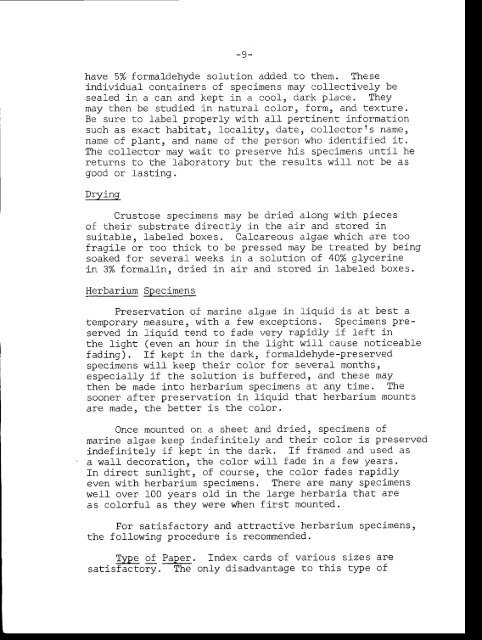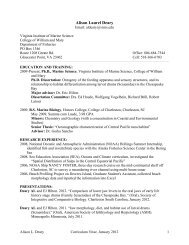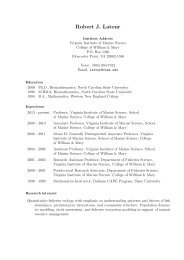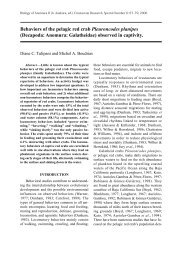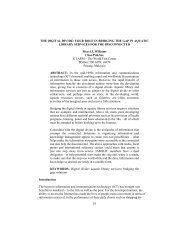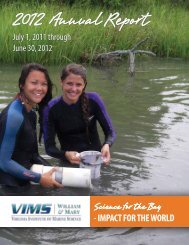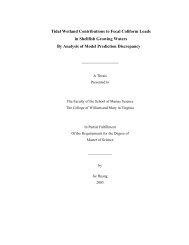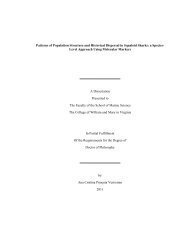Guide to the identification of marine plants and invertebrate animals ...
Guide to the identification of marine plants and invertebrate animals ...
Guide to the identification of marine plants and invertebrate animals ...
Create successful ePaper yourself
Turn your PDF publications into a flip-book with our unique Google optimized e-Paper software.
have 5% forrnal-dehyde sol-ution added <strong>to</strong> <strong>the</strong>m. These<br />
individual containers <strong>of</strong> specimens may collectively be<br />
seal-ed in a can <strong>and</strong> kept in a cool, dark place. They<br />
may <strong>the</strong>n be studied in naturaf c<strong>of</strong>or, folm, <strong>and</strong> texture.<br />
Be sure <strong>to</strong> l-abel- properly with all pertinent information<br />
such as exact habitat, locality, date, coll-ec<strong>to</strong>rrs name,<br />
name <strong>of</strong> plant, <strong>and</strong> name <strong>of</strong> <strong>the</strong> person who identified it.<br />
The col-lec<strong>to</strong>r may wait <strong>to</strong> preserve hi-s specimens until- he<br />
returns <strong>to</strong> <strong>the</strong> l-abora<strong>to</strong>ry but <strong>the</strong> results wil-l- not be as<br />
good or lasting.<br />
I lht tf hd<br />
Crus<strong>to</strong>se specimens may be dried along with pleces<br />
<strong>of</strong> <strong>the</strong>ir substrate directly in <strong>the</strong> air <strong>and</strong> s<strong>to</strong>red in<br />
suitabl-e, labeled boxes. Cal-careous algae which are <strong>to</strong>o<br />
fragile or <strong>to</strong>o thick <strong>to</strong> be pressed may be treated by being<br />
soaked for several weeks in a solutj-on <strong>of</strong> 40% glycerine<br />
in *rr 3% v/v formalin. rln-ied-in ain <strong>and</strong> s<strong>to</strong>red in l-abeled boxes.<br />
Herbarium \nanr mon q<br />
-9-<br />
Preservati-on <strong>of</strong> <strong>marine</strong> algae in liquid is at best a<br />
temporary measure, with a few exceptions. Speci-mens preserved<br />
in liquid tend <strong>to</strong> fade very rapidly if l-eft j-n<br />
<strong>the</strong> tight (even an hour in <strong>the</strong> light wil-l- cause noticeable<br />
fading). If kept in <strong>the</strong> dark, f ormal-dehyde-preserved<br />
specimens wil-L keep <strong>the</strong>ir eolor for several months,<br />
especially if <strong>the</strong> sol-ution is buffered, <strong>and</strong> <strong>the</strong>se may<br />
<strong>the</strong>n be made in<strong>to</strong> herbarium specimens at any time. The<br />
sooner after preservation in liquid that herbarium mounts<br />
-*^ --r^ *L^ lretter<br />
clr g ll<strong>to</strong>.uE 9 Ll lE r is <strong>the</strong> color.<br />
Once mounted on a sheet dnd dried, specimens <strong>of</strong><br />
<strong>marine</strong> algae keep indefinitely <strong>and</strong> <strong>the</strong>ir c<strong>of</strong>or is preserved<br />
indefi-nitely if kept in <strong>the</strong> dark. If framed <strong>and</strong> used as<br />
a walJ- decoration, <strong>the</strong> color wiJ-J- fade in a few years.<br />
In direct sunlight, <strong>of</strong> course, <strong>the</strong> c<strong>of</strong>or fades rapidly<br />
even with herbarium specimens. There are many specimens<br />
wetl- over l-00 years ol-d in <strong>the</strong> large herbaria that are<br />
as c<strong>of</strong>orful- as <strong>the</strong>y were when first mounted.<br />
For satisfac<strong>to</strong>ry <strong>and</strong> attractive herbarium specimens,<br />
<strong>the</strong> fol-l-owing procedure is recommended.<br />
Tvpe <strong>of</strong> Paper. Index cards <strong>of</strong> various sizes are<br />
satisFic<strong>to</strong>ry. The only disadvantage <strong>to</strong> this type <strong>of</strong>


